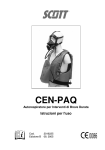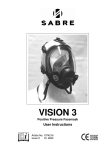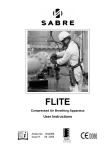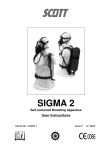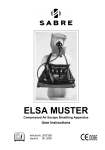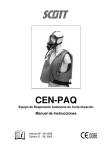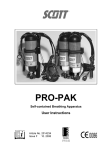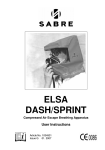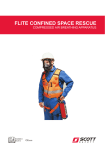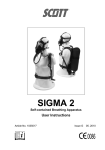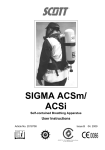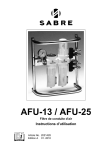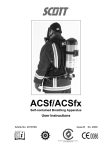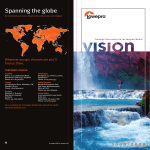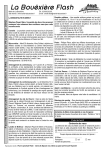Download Cen-paq User Manual in English
Transcript
CEN-PAQ Short Duration Self-contained Breathing Apparatus User Instructions Article No. 1034919 Issue H 08. 2005 Self-contained Breathing Apparatus Contents WARNINGS................................................................................................................................................................. ii 1. INTRODUCTION.............................................................................................................................................1 1.1 1.2 1.3 1.4 1.5 1.6 1.7 1.8 IMPORTANT ...............................................................................................................................................1 BREATHABLE AIR......................................................................................................................................1 COMPRESSED AIR AIRLINE SUPPLIES...................................................................................................1 APPARATUS DURATION ...........................................................................................................................2 PERSONNEL TRAINING ............................................................................................................................2 SERVICING.................................................................................................................................................2 SPARE PARTS AND ACCESSORIES ........................................................................................................3 NOTIFIED BODIES .....................................................................................................................................3 2. TECHNICAL DESCRIPTION ..........................................................................................................................3 3. QUALITY ATTRIBUTES .................................................................................................................................5 4. CHECK APPARATUS.....................................................................................................................................6 5. DONNING & OPERATING PROCEDURE – Standard Apparatus ...............................................................8 6. DONNING & OPERATING PROCEDURE – Airline Apparatus..................................................................10 7. DOFFING INSTRUCTIONS ..........................................................................................................................13 8. AFTER USE ..................................................................................................................................................14 9. SCHEDULED MAINTENANCE.....................................................................................................................16 2.1 2.2 2.3 2.4 3.1 4.1 4.2 4.3 4.4 4.5 4.6 5.1 5.2 5.3 5.4 5.5 5.6 5.7 6.1 6.2 6.3 6.4 6.5 6.6 6.7 7.1 7.2 7.3 7.4 8.1 8.2 8.3 8.4 8.5 9.1 9.2 PNEUMATICS .............................................................................................................................................4 REDUCER...................................................................................................................................................4 DEMAND VALVE ........................................................................................................................................4 FACEMASK.................................................................................................................................................5 NOTIFIED BODIES .....................................................................................................................................5 FIT FULLY CHARGED CYLINDER.............................................................................................................6 CHECK DEMAND VALVE ...........................................................................................................................6 CHECK CYLINDER PRESSURE / LEAK TEST ..........................................................................................7 WHISTLE TEST ..........................................................................................................................................7 FIT CLEAN FACEMASK .............................................................................................................................7 CHECK APPARATUS .................................................................................................................................7 DON APPARATUS......................................................................................................................................8 CHECK DEMAND VALVE ...........................................................................................................................8 OPEN CYLINDER VALVE...........................................................................................................................9 DON FACEMASK........................................................................................................................................9 POSITIVE PRESSURE TEST .....................................................................................................................9 WHISTLE / FACESEAL TEST ....................................................................................................................9 CHECK CYLINDER PRESSURE ..............................................................................................................10 DON APPARATUS....................................................................................................................................10 CHECK DEMAND VALVE .........................................................................................................................11 CONNECT SUPPLY..................................................................................................................................11 FIT FACEMASK ........................................................................................................................................11 POSITIVE PRESSURE TEST ...................................................................................................................11 FACESEAL TEST......................................................................................................................................12 OPERATING CYLINDER SUPPLY ...........................................................................................................12 REMOVE FACEMASK ..............................................................................................................................13 TURN OFF CYLINDER VALVE / DISCONNECT SUPPLY .......................................................................13 REMOVE APPARATUS ............................................................................................................................14 CLEAN & TEST APPARATUS ..................................................................................................................14 CLEAN FACEMASK..................................................................................................................................14 CLEAN APPARATUS................................................................................................................................15 CHECK APPARATUS ...............................................................................................................................15 RECORD TEST DETAILS.........................................................................................................................15 STORAGE.................................................................................................................................................16 MONTHLY.................................................................................................................................................16 ANNUALLY ...............................................................................................................................................16 Registered office: Scott Health and Safety Limited, Pimbo Road, West Pimbo, Skelmersdale, Lancashire, WN8 9RA, United Kingdom. i WARNINGS Please Read Carefully and Fully Understand This manual is for use by personnel trained in the use and care of compressed air breathing apparatus, and MUST NOT be used as a self-teaching guide by untrained users. Failure to understand or adhere to the CEN-PAQ user instructions may result in injury or death. Scott Health and Safety Limited have taken great care to ensure that the information in this manual is accurate, complete and clear. However, Training & Technical Support Services will be pleased to clarify any points in the manual and answer questions on SCOTT breathing apparatus. The following warnings are in accordance with certifying authority requirements and apply to the use of breathing apparatus in general: Breathing apparatus users must be fully trained in the use and care of selfcontained, compressed air breathing apparatus. Ensure that the selection of the apparatus type is sufficient for the tasks being undertaken and the hazards likely to be encountered. Please refer to National Regulations for guidance. Adequate protection may not be provided in certain highly toxic atmospheres. The apparatus must be tested and serviced in accordance with Section 9 Scheduled Maintenance and the notes in Section 1 under Servicing. The quality of air used to supply and charge breathing apparatus must meet the requirements of EN 12021 : 1995. See Section 1 for details. Ensure that a good seal can be obtained between the face and facemask. The wearing of beards, side-burns or spectacles may adversely affect the sealing of a facemask to the wearer's face. At high work rates, facemask pressure may become negative at peak inhalation. The apparatus is not designed for use underwater. The waistcoat/harness must not be used as a vehicle seat restraint. DISCLAIMER Failure to comply with these instructions or misuse of the apparatus may result in: death, injury or material damage, and invalidate any warranty or insurance claims. COPYRIGHT This manual must not be copied in part or in whole, or used for purposes other than its intended purpose without the written permission of Scott Health and Safety Limited. ii CEN-PAQ National regulations must be observed. 1. INTRODUCTION 1.1 The mineral oil content shall be such that the air is without the odour of oil. The odour threshold is in the region of 0.3 mg/m3. IMPORTANT CEN-PAQ must be serviced in accordance with the Servicing Schedule on at least an annual basis. Please refer to notes under Servicing. The water content shall not exceed 50 mg/m3 for 200 bar apparatus and 30 mg/m3 for 300 bar apparatus. These instructions for the use, care and maintenance of the apparatus must be followed to ensure the correct and safe operation of CEN-PAQ. For airline apparatus, air must be used with a dew-point sufficiently low to prevent internal freezing. For any enquiries regarding the use of SCOTT breathing apparatus, please contact Training & Technical Support Services at Scott Health and Safety Limited. 1.2 1.3 Air for use with compressed air airlines must conform to prEN 12021 : 1995 and must have a dew point sufficiently low to prevent internal freezing when apparatus is used in temperatures below 4°C. BREATHABLE AIR Air used to supply or charge breathing air may be natural or synthetic. The composition of breathable air is given in Table 1. COMPONENT OXYGEN MASS % (Dry Air) 23.14 COMPRESSED AIR AIRLINE SUPPLIES VOLUME % (Dry Air) No. of Wearers Airflow (L/min.) 1 300 2 450 3 750 4 20.948 900 75.52 78.08 Table 2 ARGON 1.29 0.93 CARBON DIOXIDE 0.05 0.031 4 Airline pressure must be between 5.0 9.0 bar (70 - 130psi). Airflow supply capacity for a single airline is given in Table 2. NITROGEN HYDROGEN 0.000 003 0.000 05 NEON 0.001 270 0.001 818 HELIUM 0.000 037 0.000 524 KRYPTON 0.000 330 0.000 114 XENON 0.000 039 0.000 009 Generally, each additional wearer requires an extra 150 litres/minute, each additional pair of wearers requires 300 L/min for one wearer and 450 L/min for two wearers. All measurements must be taken at the wearer end of the airline. Table 1: Breathable Air Example: for 8 users (4 pairs) the recommended flow is 4 x (300 + 150) = 1800 litres/minute. There is an increased fire risk when the oxygen content is above the value shown above. An Airline Flow Tester is available from Scott Health and Safety Limited under Article Number 1035978. The purity/quality of air used to supply and charge breathing apparatus should be tested periodically in accordance with national regulations. Unless specified otherwise, contaminants shall not exceed permissible exposure level. the the 1 CEN-PAQ Compressed air airlines used with CEN-PAQ must be SCOTT products, approved to EN 139. 1.5 Personnel who use self-contained, compressed air breathing apparatus must be fully trained in accordance with these instructions and national regulations. Ensure that hoses used in an explosive or inflammable atmosphere are marked ANTI-STATIC – EN 139. These instructions cannot replace an accredited training course run by fully qualified instructors in the proper and safe use of SCOTT breathing apparatus. Cost effective PVC hoses may be used in other atmospheres. SCOTT manufacture a range of antistatic and PVC hoses, in lengths ranging from 15m to 60m. Customer Services will be pleased to advise on price and delivery. 1.4 PERSONNEL TRAINING Please contact Training & Technical Support Services or your SCOTT distributor for training course details. Training & Technical Support Services: Scott Health and Safety Limited Pimbo Road, West Pimbo, Skelmersdale, Lancashire, WN8 9RA, United Kingdom. APPARATUS DURATION All durations quoted are nominal, based on an Average Wearer Consumption Rate of 40 litres/minute and FULLY CHARGED cylinders. Actual Wearer Consumption rates vary due to many factors, such as: 1. Workload: high work rates increase consumption rates. 2. Weight of apparatus and use of heavy or restrictive clothing. 3. Work environments with extremes of heat or cold. 4. Physical fitness of the wearer. 5. Other factors include emotional stress and fatigue. Tel: +44 (0) 1695 711711 Fax: +44 (0) 1695 711775 1.6 SERVICING CEN-PAQ must be serviced at scheduled intervals by personnel who have completed a formal training course and hold a current certificate for servicing and repairing SCOTT breathing apparatus. Details of the servicing schedule are contained in the SCOTT CEN-PAQ Service Manual, copies of which can only be obtained by registered holders of a current certificate. It is important that all wearers are aware of these factors and take account of them when assessing cylinder duration. Your SCOTT distributor or Training & Technical Support Services will be pleased to provide training course details and quotes for service contracts. Please see above for contact details. The Total Duration for the apparatus is calculated to be 15 minutes for 200 bar cylinders and 20 minutes for 300 bar cylinders based on a free air capacity of 600 or 820 litres and an Average Wearer Consumption Rate of 40 litres/minute. The Warning Period is calculated to be 5 minutes based on a 68 bar whistle and a 3 litre cylinder. The Nominal Duration for the apparatus is therefore 10 or 15 minutes. 2 CEN-PAQ 1.7 2. TECHNICAL DESCRIPTION SPARE PARTS AND ACCESSORIES Our Customer Services Department provide an efficient friendly, customer contact point for ordering new apparatus, spare parts and accessories. The team can also provide general information on SCOTT products. The CEN-PAQ is a waistcoat-mounted, short duration, self-contained breathing apparatus. The apparatus is available in two versions, a standard SCBA version and an airline version. Customer Services: Scott Health and Safety Limited Pimbo Road, West Pimbo, Skelmersdale, Lancashire, WN8 9RA, United Kingdom. The airline version is fitted with a waistbelt-mounted manifold allowing the apparatus to be supplied from a breathable compressed airline supply. The apparatus is certified to European Standard EN 137 for self-contained breathing apparatus and EN 139 for airline apparatus and has been issued with a 'CE' mark. Tel: +44 (0) 1695 711711 Fax: +44 (0) 1695 711775 1.8 NOTIFIED BODIES Inspec International Ltd (No. 0194) Upper Wingbury Courtyard, Wingrave, Aylesbury, Buckinghamshire, HP22 4LW, United Kingdom. The apparatus comprises a waistcoat, a high-pressure air cylinder, two stage pneumatic system with pressure reducer and demand valve; and a facemask. The facemask-mounted, high performance demand valve ensures that positive pressure is maintained within the facepiece, thus providing the highest degree of respiratory protection. British Standards Institute (No. 0086) 389 Chiswick High Road, London, W4 4AL, United Kingdom. For airline apparatus, a medium pressure, compressed airline supply is connected to a waistbelt-mounted manifold, thus supplying air directly into the medium pressure port on the pressure reducer. A 3-litre water capacity, 200 or 300 bar cylinder which provides a free air capacity of 600 or 820 litres is mounted in a pouch on the back of the jacket. This allows a total duration of 15 or 20 minutes when used at an average wearer consumption rate of 40 litres/minute, (please refer to Section 1.4 - Apparatus Duration for further details). The apparatus utilises a waistcoat fabricated from either a high visibility P.V.C. or a black, anti-static material. The standard apparatus features a double-breasted VelcroTM fastening waistcoat whereas anti-static and airline versions feature a double buckle closure. 3 CEN-PAQ The pressure reducer operates on a selfregulating, spring-loaded piston principle that is completely automatic in operation and requires no adjustment. The high visibility waistcoat MUST NOT be used in potentially explosive or flammable atmospheres. The waistcoat is designed to fit a wide range of body sizes with the minimum of adjustment. A restrictor within the reducer body prevents air loss in excess of 25 litres per minute should the gauge, whistle or hose become damaged. The alloy steel cylinder has a brass cylinder valve with a handwheel. A safety lock on the handwheel prevents accidental valve closure. The cylinder is retained in the pouch by a tough, dual action buckle. 2.1 A pressure relief valve prevents overpressurisation of the medium pressure breathing circuit. An outlet pressure of between 5.0 and 11.0 bar from the reducer is supplied to the facemask-mounted demand valve. PNEUMATICS High-pressure air from the cylinder is connected through the cylinder valve and a length of high-pressure hose to a pressure reducer. A sintered filter in the connector prevents the ingress of dirt and debris. 2.3 DEMAND VALVE Air from the reducer is connected through a reinforced chlorinated polyethylene hose to the facemask-mounted DV, which regulates the air supplied to the wearer. A high-pressure hose from the reducer supplies air to the shoulder-mounted pressure gauge and warning whistle assembly. The gauge dial has photoluminescent markings to improve lowlight legibility. The gauge is protected by means of a rubber shroud. The warning whistle operates at 68 bar, when there is at least 200 litres of air left in the cylinder, giving a warning period of 5 minutes when consumed at 40 litres/minute (please refer to Section 1.4 Apparatus Duration for further details). The high-pressure hose has a minimum burst pressure of 800 bar. 2.2 The DV operates in conjunction with the facemask spring-loaded exhale valve to maintain a positive pressure within the facemask. REDUCER The DV has a servo-assisted tilting diaphragm mechanism that responds to pressure changes within the facemask to regulate the flow of air to the mask, ensuring that pressure within the mask remains safely above ambient. The DV has a reset button that enables wearers to close the airflow through the DV, permitting the facemask to be removed during test procedures and at the end of a task, without loss of cylinder air. 4 CEN-PAQ When the apparatus is donned, the DV is normally “reset” (closed) and is opened (activated) when the wearer takes a first breath. 3. QUALITY ATTRIBUTES CEN-PAQ is approved to European Standards EN 137 (Self-contained breathing apparatus) and is ‘CE’ marked in accordance with EEC Directive EC/686/1986. The DV has a supplementary flow device (bypass), that the wearer can open using the bypass knob. When the bypass is used the unregulated flow of air through the DV reduces cylinder duration. 3.1 The DV is connected to the facemask by a Quick-Fit (QF) bayonet fitting with a spring-loaded locking catch to prevent accidental disconnection. 2.4 FACEMASK British Standards Institute (No. 0086) 389 Chiswick High Road, London, W4 4AL, United Kingdom. CEN-PAQ is approved for use with the PanaSeal facemask. The PanaSeal facemask is made from non-dermatitic materials and is available in either black neoprene or blue silicone and is retained using a fully adjustable five-point head harness. The mask is approved to EN 136 for use with positive pressure breathing apparatus. A speech communication. diaphragm NOTIFIED BODIES Inspec International Ltd (No. 0194) Upper Wingbury Courtyard, Wingrave, Aylesbury, Buckinghamshire, HP22 4LW, United Kingdom. aids The mask incorporates an inner mask that reduces carbon dioxide 'dead space' and prevents visor misting. The polycarbonate visor meets the requirements of EN 136, Part 10, for impact resistance and optical clarity. A version of the PanaSeal facemask is also available for use with the GalletTM helmet. For airline equipment, the maximum allowable length of supply hose is 90 metres. 5 CEN-PAQ 4. CHECK APPARATUS 2. Check O-ring on cylinder connector to ensure that it is clean and in good condition. 1. Check apparatus to ensure that it is clean and in good condition. 3. Screw handwheel connector fully into cylinder valve outlet. 2. Fully slacken waistbelts, remove facemask from pouch and slacken head harness, ready for use. 4.2 4.1 CHECK DEMAND VALVE FIT FULLY CHARGED CYLINDER 1. Check red bypass knob is in the 'OFF' position and depress black rubber reset button. 1. Slide fully charged cylinder into pouch and secure using buckle positioned behind cylinder valve i.e. towards the wearer. WARNING: DO NOT use cylinders of different sizes or specifications. 6 CEN-PAQ 4.3 CHECK CYLINDER PRESSURE / LEAK TEST 4.5 1. Check that orange O-ring on demand valve outlet is clean and in good condition. 1. Slowly open cylinder valve fully, check pressure gauge to ensure that the cylinder is at least 80% FULL: For 200 bar cylinders - 160 bar. For 300 bar cylinders - 240 bar. 2. Fit demand valve to facemask, checking that coupling is secure by rotating valve back and forth. 4.6 2. Close cylinder valve and time for one minute, observing pressure gauge. The reading must not fall by more than 10 bar in this time. 4.4 FIT CLEAN FACEMASK CHECK APPARATUS WHISTLE TEST 1. Slacken all straps and check apparatus to ensure that it is clean and in good condition. 1. Open bypass knob slightly to vent air from system. Check that the whistle sounds clearly at between 63 and 73 bar. When all air has been released, close bypass. 2. Stow facemask in pouch. 3. Apparatus is now ready for use. 4. If apparatus fails test DO NOT USE. Attach explanatory note to apparatus and return for servicing. 7 CEN-PAQ 5. DONNING & OPERATING PROCEDURE – Standard Apparatus 5.1 DON APPARATUS 3. Pass left side of jacket around outside and secure buckle, pull strap and adjust for a comfortable fit. Tuck loose ends of straps inside waistcoat. 5.2 1. For VelcroTM fastened waistcoats: Fit left side of jacket to inside and pass right side around outside and secure for a snug fit. CHECK DEMAND VALVE 1. Remove facemask from stowage pouch and hang from strap around neck. 2. Check demand valve to ensure that the red bypass knob is in the 'OFF' position and depress black reset button. 2. For black waistcoats: Pass right side of jacket to inside and secure buckle. Pull strap to adjust for comfortable fit. 8 CEN-PAQ 5.3 OPEN CYLINDER VALVE 5.5 1. Open cylinder valve fully. Check pressure gauge to ensure that the cylinder is at least 80% FULL: For 200 bar cylinders - 160 bar. For 300 bar cylinders - 240 bar. 5.4 POSITIVE PRESSURE TEST 1. Insert finger under face-seal and check for a steady outward flow of air. 2. Remove finger and allow facemask to re-seal. 5.6 DON FACEMASK WHISTLE / FACESEAL TEST 1. Release the handwheel lock and close the cylinder valve. Keep hold of the handwheel. 1. With head harness straps fully slackened, place chin into chin-cup and pull harness straps over back of head. 2. Hold breath and listen carefully for any leaks. Check pressure gauge as movement of the needle indicates a leak. 2. Tighten head harness straps in sequence: bottom, middle, top. DO NOT over-tighten. 3. If test fails, open cylinder valve, slacken head harness, adjust mask and repeat test as required. 3. Inhale sharply to actuate first breath mechanism. Breathe normally. 9 CEN-PAQ 4. Slowly breathe down air in system. Check pressure gauge to ensure that whistle sounds clearly at 55 bar ±5 bar. 6. DONNING & OPERATING PROCEDURE – Airline Apparatus 5. Open cylinder valve fully upon completion. 6. If leak persists, DO NOT use. Attach explanatory note and return for servicing. 5.7 6.1 DON APPARATUS CHECK CYLINDER PRESSURE 1. Pass right side of jacket to inside and secure buckle. 2. Adjust strap for comfortable fit. 1. Turn the red bypass to ON and check that there is a steady flow of air into the mask. Turn the bypass to OFF. 2. Check pressure gauge to ensure that the cylinder is at least 80% FULL: For 200 bar cylinders - 160 bar. For 300 bar cylinders - 240 bar. 3. Ensure that there is sufficient air in the cylinder for the tasks to be performed. 4. The apparatus is ready for use. 3. Pass left side of jacket around outside and secure buckle, pull strap and adjust for a comfortable fit. 10 CEN-PAQ 4. Tuck loose ends of straps inside waistcoat. 6.4 FIT FACEMASK WARNING: Ensure that the cylinder valve is turned OFF. 6.2 CHECK DEMAND VALVE 1. With head harness straps fully slackened, place chin into chin-cup and pull harness straps over back of head. 1. Remove facemask from stowage pouch and hang mask from strap around neck. 2. Tighten head harness straps in sequence: bottom, middle, top. DO NOT over-tighten. 2. Check demand valve to ensure that the red bypass knob is in the 'OFF' position and depress black reset button. 6.3 3. Inhale sharply to actuate first breath mechanism. Breathe normally. CONNECT SUPPLY 6.5 POSITIVE PRESSURE TEST 1. Connect airline supply hose to plug connector on waistbelt. Firmly pull on connector to ensure that coupling is secure. WARNING: Airline supply pressure and flow must be checked to ensure it meets the requirements of Section 1.3. 1. Insert finger under faceseal and check for a steady outward flow of air. Remove finger and allow mask to re-seal. 11 CEN-PAQ 6.6 FACESEAL TEST 6.7 OPERATING CYLINDER SUPPLY 1. DO NOT operate cylinder supply whilst connected to airline supply unless in the process of egress or escape. WARNING: Operating the bypass facility whilst using the cylinder supply will significantly reduce the duration of the apparatus. 1. Push hose couplings together and pull back collar to release supply hose. 2. Breathe normally until mask is pulled gently onto face and hold breath for 10 seconds. Any leakage will be indicated by the mask moving away from the face. 3. Re-connect coupling and breathe normally upon completion. 4. Hold breath and listen for any audible leaks. 5. If test fails, slacken then adjust head-harness and repeat test as required. 2. Open cylinder valve fully. 6. If leak persists, DO NOT USE. Attach explanatory note to apparatus and return for servicing. 7. Open bypass on demand valve to check for steady inward flow of air, close on completion. 8. Once satisfied with apparatus, proceed to undertake tasks as required. 3. Push hose couplings together and pull back collar to release supply hose. 4. Breathe normally and continue as required. 12 CEN-PAQ 7. DOFFING INSTRUCTIONS 7.1 7.2 REMOVE FACEMASK TURN OFF CYLINDER VALVE / DISCONNECT SUPPLY WARNING: DO NOT remove apparatus until clear of the hazard area. 1. Disengage handwheel locking mechanism and close cylinder valve. 1. Take a deep breath and depress black reset button on demand valve. 2. Push hose couplings together and pull back collar to release supply hose. 3. Turn red bypass knob to 'ON' position and bleed air from system. 2. Release head harness by pulling metal buckles forward. 3. Hang mask from strap around neck. 13 CEN-PAQ 7.3 8. AFTER USE REMOVE APPARATUS 1. Stow mask in pouch and secure to waistcoat. Cautions: • DO NOT immerse the demand valve or warning whistle in water. A yellow cap is provided to cover the demand valve outlet. • USE ONLY the specified method and substances to clean the apparatus. • The apparatus MUST be thoroughly dried prior to storage, in particular the facemask and valve flaps. 8.1 CLEAN FACEMASK 1. Withdraw red locking catch and turn demand valve 90° clockwise to disconnect demand valve from facemask. 2. Release apparatus. waistbelt to 2. Wash mask thoroughly in a hand hot solution of TriGeneTM Cleansing and Disinfecting Solution. See Note below. remove 3. Unscrew handwheel connector and release buckle to remove cylinder. 3. Rinse mask thoroughly in clean running water, paying particular attention to flushing out the exhale valve. 4. Hang mask by neckstrap and allow to dry thoroughly away from direct heat or sunlight. 5. When dry, wipe facemask seals with TriGeneTM disinfectant wipes. 6. Polish visor inside and out with a clean, lint-free cloth. Fit ‘Visorguard’ to protect visor if desired. 7. Slacken head harness, ready for use. Note: TriGeneTM Cleansing and Disinfecting Solution is available from Scott Health and Safety Limited in 1 litre and 5 litre containers under Article Numbers 2008247 and 2008248 respectively. 4. Mark cylinder as empty (if used) and return for charging. 7.4 CLEAN & TEST APPARATUS Pump dispensers are available for the above under Article Numbers 1017672 (1 litre) and 1017670 (5 litres). The apparatus must be cleaned and tested in accordance with the instructions given in Section 8 - After Use, prior to being returned into service. TriGeneTM Disinfecting Wipes are available from Scott Health and Safety Limited in packs of 20 sachets under Article Number 2004225. 14 CEN-PAQ 8.2 Notes: • Due to the configuration of the apparatus, it is not necessary to decontaminate the internal components of the demand valve. • DO NOT immerse or attempt to clean the internals of the demand valve. CLEAN APPARATUS 4. Examine waistcoat to ensure that it is clean and undamaged. In particular examine for signs of abrasion or fraying. Note: It is possible to wash the waistcoat separately, provided the pneumatic assembly is removed. Please refer to the CEN-PAQ Service Manual for details. 5. Carefully examine apparatus for signs of wear or damage, ensuring that any faults are rectified immediately in accordance with the servicing instructions. 1. Fully slacken waistbelt straps. 6. Functionally check the apparatus in accordance with instructions provided within Section 4 of this manual. 2. Clean off any dirt by sponging down with a warm water and soap solution followed by a thorough rinse. 8.3 8.4 CHECK APPARATUS RECORD TEST DETAILS Record test details in accordance with local regulations in a breathing apparatus logbook (available from Scott Health and Safety Limited under Article Number 1034745). Information recorded usually includes: • Name and address of employer responsible for the apparatus. • Make, model number or mark of the apparatus, together with a description of any distinguishing features, sufficient to enable clear identification. • The date of the examination together with the name, signature or unique authentication mark of the examiner. • The condition of the apparatus and details of any defects found and any remedial action taken, including any airline supply equipment used with the apparatus. • Cylinder air pressure. 1. Check that the demand valve locking catch is free to move without sticking by depressing the catch a number of times. 2. To clean catch, cover valve outlet with yellow cap and use a small brush and soap solution to clean around catch. 3. If catch is not free moving, attach explanatory note to apparatus and return for servicing. 15 CEN-PAQ 8.5 9. SCHEDULED MAINTENANCE STORAGE The apparatus must be stored in a clean dry environment away from direct heat and sunlight. 9.1 Storage temperature should not exceed +40°C to -10°C. MONTHLY The apparatus should be examined and tested at least once a month in accordance with the instructions given in this manual under Check Apparatus. Details of such checks should be recorded within the appropriate register and a copy kept for future inspection. Please see Section 8.4 for details. 9.2 ANNUALLY The apparatus must be tested and components replaced in accordance with the CEN-PAQ Service Schedule, contained within the CEN-PAQ Service Manual. Please refer to notes under Personnel Training and Servicing at the beginning of this manual for further details. 16 Scott Health and Safety Limited Pimbo Road, West Pimbo, Skelmersdale, Lancashire, WN8 9RA, United Kingdom. Tel: +44 (0) 1695 711711 Fax: +44 (0) 1695 711775





















